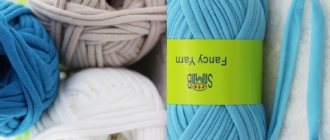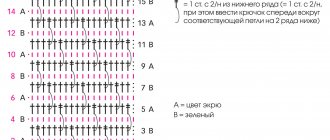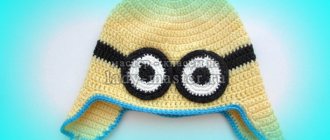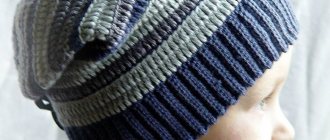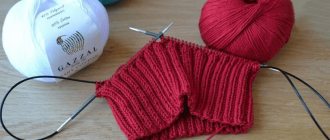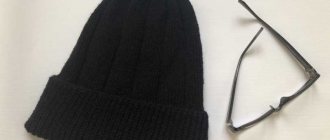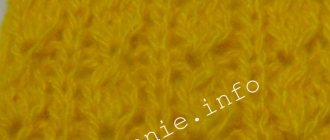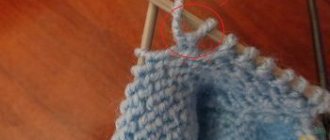Brioche - a new knitting technique
Every craftswoman, having mastered one type of knitting, strives to learn and try a new technique. We bring to your attention a popular brioche knitting technique.
The good thing about the patterns is that they won’t seem complicated even for beginners. If you know how to knit 1×1 elastic, then in a few hours a fashionable item may appear in your wardrobe.
The basis of the new product is English or patent elastic. With its help you can create unprecedented patterns.
Style Feature
Hats, mittens and scarves look so original that they will certainly attract attention. The fabric is elastic, warm, and not windproof. Ideal for early spring.
If you knit the back and face with threads of different colors, then you will have the opportunity to choose the side that will match the clothes you have chosen for the day.
The peculiarity of elastic bands of different colors is the repeated knitting of one row with threads of a different shade. Therefore, for work, prepare not circular knitting needles, but with two ends.
Knitting items from threads of two colors
Prepare circular or double needles, as well as 2 colors of yarn of the same thickness.
Description of two-color knitting option:
- Knit tightly, but do not pull.
- Form the pattern by decreasing and adding stitches in the purl row, next to the edge loop.
- You should decrease or increase 3-5 stitches before the edge.
- Decrease to the right. The fabric is made with front and back loops, knitted alternately. This means we will do the decrease using three stitches – knit, purl, knit. To decrease to the right, remove the knit stitch on the right needle without knitting, and purl the knit stitch, return it to the left needle, and pull it through the next knit stitch. Then pull the resulting loop through the first removed knit stitch.
- Decrease to the left. On the right needle, slip the first knit stitch, purl the knit stitch, then pull through the first slip stitch. Return the resulting loop to the left needle and pull it through the next stitch. loop.
- Addition. Only the front loop is used here. From one knit you need to get 3: knit, yarn over, knit. Important: in which direction we perform the decrease, we put on that loop last.
Hat Leaves from Raina Kruus in brioche technique
The hat is knitted using the brioche technique, with a patent pattern of threads of two colors. The hat is double-sided. The pattern looks the same both from the front and from the back.
The main and background threads change places when moving from the face to the wrong side, but the design itself looks the same.
The hat is knitted on circular knitting needles. First comes the elastic band, which smoothly turns into a leaf pattern. The leaves themselves are formed by rhythmically adding and decreasing stitches (pts).
- 2 – adding 4 pts
- 3 – decrease 4 pt
- 4 – how to use additional knitting needles.
To enhance the impression of the design and the special technique of execution, we choose sectional dyed yarn.
Designer hat sizes
The circumference length when stretched is 57 cm, and when at rest it is 48 cm, with a height of 26 cm.
Materials
The author suggests using Debbie Bliss DK Rialto (50 g/105 m), a high quality merino yarn. You will need 2 skeins of different colors of yarn, contrasting. Let's call them color OC and color SS.
We will knit with stocking and circular knitting needles of the same diameter of 3.5 mm. An additional knitting needle will be required.
We will knit the sample to determine the density using the main pattern, which is described below:
10x10 cm = 24 rows of 20 pt.
Legend
- ltspt - facial pt
- ltspt/snack – knit stitch with double crochet
- pt/snack – pt with double crochet
- izpt - purl pt
- izpt/snak – purl pt with double crochet
- CH – remove Fri
- PR – before work
Description of a knitted hat with a patent “leaves” pattern from Raina Kruus
Take the OC thread and cast on 98 pt. We note that this is the front side of the hat; we will not turn the canvas over.
Move the st to the other end, take the SS thread and knit the starting row:
— PR thread; * DC 1 st/dc; 1 izpt; repeat from * to k/r.
We especially note that the 1st stitch in the k/r should be double crochet.
We close the pt in a circle, put a marker at the beginning of the circle. We begin to knit a patent elastic band, or a “Brioche” elastic band, starting with the next k/r. We will number the rows for each thread color independently.
1st k/r OT: *1 lcpt/snak; DC 1 st/dc; repeat from * to k/r; leave the OC thread PR.
1st k/r SS: * DC 1 pt/sn; 1 ltspt/snak; repeat from * to k/r.
According to the brioche technique, this is one k/r, although physically there are 2 of them, one for each of the threads.
We perform the described 2 k/r to a height of 4 cm. This will turn out to be 8 or 9 repetitions.
The following books come with additions.
1st c/r OC:
- * perform the group 4 times [1 lcpt/snack; DC 1 st/dc];
- add 2 pt: 1 lcpt/snack; leave it on the left knitting needle; 1 yarn over; We knit 1 lcpt/snack in the same st = 2 sts added;
- DC 1 st/dc; perform the group 2 times [1 lcpt/snack; DC 1 st/dc]; repeat from * to k/r.
1st k/r SS: *DC 1 st/sn; 1 izpt/snak; repeat from * to k/r.
2nd k/r OC: * 1 lcpt/snak; DC 1 st/dc; repeat from * to k/r.
2nd k/r SS: *DC 1 st/sn; 1 izpt/snak; repeat from * to k/r.
**Next k/r we begin to design the leaves of the main pattern.
1st c/r OC:
— *add 4 pt: 1 lcpt/snack; leave it on the left knitting needle; 1 yarn over; 1 ltspt/snak; 1 yarn over; 1 ltspt/snak; we connect all this into one pt - so, we added 4 pts.
Next c/r:
- — CH 1 pt/sn; 1 lcpt; DC 1 st/dc; 1 lcpt; DC 1 pt/sn = 5 pt;
- — CH 1 pt/sn; 2 times [1 lcpt/snack; DC 1 st/dc];
- - decrease 4 pt: CH 2 lt; transfer the next point to the additional spoke PR; 1 lcpt; stretch the 2nd slipped stitch over this stitch; transfer the st to the left needle and pull the remaining st through it - decrease 4 sts;
- — 2 times [1 lcpt/snack; DC 1 st/dc]; repeat from * to k/r.
1st k/r SS: * DC 1 pt/sn; 1 izpt/snak; repeat from * to k/r.
2nd k/r OC: * 1 lcpt/snak; DC 1 st/dc; repeat from * to k/r.
2nd k/r SS: * DC 1 st/sn; 1 izpt/snack; repeat from * to k/r.
These 2 k/r, the last ones, are performed 1 more time, these will be the 3rd k/r OC and the 3rd k/r SS.
4th quarter OC:
- — * 1 lcpt/snak; DC 1 st/dc; add 4 pt; DC 1 st/dc;
- — 2 times [1 lcpt/snack; DC 1 st/dc]; subtract 4 pt; DC 1 st/dc;
- — 1 ltspt/snack; DC 1 st/dc; repeat from * to k/r.
4th k/r SS: * DC 1 st/sn; 1 izpt/snak; repeat from * to k/r.
5th k/r OC: * 1 lcpt/snack; DC 1 st/dc; repeat from * to k/r.
5th k/r SS: * DC 1 st/sn; 1 izpt/snack; repeat from * to k/r.
These 2 k/r, the last ones, are performed 1 more time, these will be the 6th k/r OC and the 6th k/r SS.
7th k/r OC:
- — * 2 times [1 lcpt/snack; DC 1 st/dc]; add 4 pt; DC 1 st/dc;
- — 2 times [1 lcpt/snack; DC 1 st/dc]; subtract 4 pt; DC 1 st/dc; repeat from * to k/r.
7th k/r SS: * DC 1 st/sn; 1 izpt/snak; repeat from * to k/r.
8th k/r OC: * 1 lcpt/snack; DC 1 st/dc; repeat from * to k/r.
8th k/r SS: * DC 1 st/sn; 1 izpt/snak; repeat from * to k/r.
These 2 k/r, the last ones, are performed 1 more time, these will be the 9th k/r OC and the 9th k/r SS.
- interesting selection on knitka.ru!!!
- A selection of knitted women's hats
Next we knit a little differently.
1st c/r OC:
- — * 2 times [1 lcpt/snack; DC 1 st/dc]; subtract 4 pt; DC 1 st/dc;
- — 2 times [1 lcpt/snack; DC 1 st/dc]; add 4 pt; DC 1 st/dc; repeat from * to k/r.
1st k/r SS: * DC 1 pt/sn; 1 izpt/snak; repeat from * to k/r.
2nd k/r OC: * 1 lcpt/snak; DC 1 st/dc; repeat from * to k/r.
2nd k/r SS: * DC 1 st/sn; 1 izpt/snack; repeat from * to k/r.
These 2 k/r, the last ones, are performed 1 more time, these will be the 3rd k/r OC and the 3rd k/r SS in the new numbering.
4th quarter OC:
- — * 1 lcpt/snack; DC 1 st/dc; subtract 4 pt; DC 1 st/dc;
- — 2 times [1 lcpt/snack; DC 1 st/dc]; add 4 pt; DC 1 st/dc; 1 ltspt/snak; DC 1 st/dc; repeat from * to k/r.
4th k/r SS: * DC 1 st/sn; 1 izpt/snak; repeat from * to k/r.
5th k/r OC: * 1 lcpt/snack; DC 1 st/dc; repeat from * to k/r.
5th k/r SS: * DC 1 st/sn; 1 izpt/snack; repeat from * to k/r.
These 2 k/r, the last ones, are performed 1 more time, these will be the 6th k/r OC and the 6th k/r SS.
7th k/r OC:
- - * decrease 4 pt; DC 1 st/dc;
- — 2 times [1 lcpt/snack; DC 1 st/dc]; add 4 pt; DC 1 st/dc;
- — 2 times [1 lcpt/snack; DC 1 st/dc]; repeat from * to k/r.
7th k/r SS: * DC 1 st/sn; 1 izpt/snak; repeat from * to k/r.
8th k/r OC: * 1 lcpt/snack; DC 1 st/dc; repeat from * to k/r.
8th k/r SS: * DC 1 st/sn; 1 izpt/snak; repeat from * to k/r.
These 2 k/r, the last ones, are performed 2 more times.
Then you can repeat from ** as many times as you see fit.
After this, we begin to decrease the stitches, rounding the cap towards the top.
1st c/r OC:
- — * 3 times [1 lcpt/snack; DC 1 st/dc]; subtract 4 pt; DC 1 st/dc;
- — 2 times [1 lcpt/snack; DC 1 st/dc]; rep from * to k/r = 84 pt.
1st k/r SS: * DC 1 pt/sn; 1 izpt/snak; repeat from * to k/r.
2nd k/r OC: * 1 lcpt/snak; DC 1 st/dc; repeat from * to k/r.
2nd k/r SS: * DC 1 st/sn; 1 izpt/snack; repeat from * to k/r.
These 2 k/r, the last ones, are performed 2 more times.
4th quarter OC:
— * 2 times [1 lcpt/snack; DC 1 st/dc]; subtract 4 pt; DC 1 st/dc;
1 ltspt/snak; DC 1 st/dc; rep from * to k/r = 56 pt.
4th k/r SS: * DC 1 st/sn; 1 izpt/snak; repeat from * to k/r.
5th k/r OC: * 1 lcpt/snack; DC 1 st/dc; repeat from * to k/r.
5th k/r SS: * DC 1 st/sn; 1 izpt/snack; repeat from * to k/r.
These 2 k/r, the last ones, are performed 2 more times.
7th k/r OT: *1 lcpt/snak; DC 1 st/dc; subtract 4 pt; repeat from * to k/r = 28 pt
7th k/r SS: * DC 1 st/sn; 1 izpt/snak; repeat from * to k/r.
8th k/r OC: * 1 lcpt/snack; DC 1 st/dc; repeat from * to k/r.
8th k/r SS: * DC 1 st/sn; 1 izpt/snak; repeat from * to k/r.
These 2 k/r, the last ones, are performed 2 more times.
10th k/r OC:
- - * center decrease: CH 1 pt as lcpt; 2 lcpt/snak together; we stretch the received stitch through the removed stitch;
- — CH 1 pt/sn; rep from * to k/r = 14 pt.
10th k/r SS: * DC 1 st/sn; 1 izpt/snack; repeat from * to k/r.
11th k/r OC: * 1 lcpt/snack; DC 1 st/dc; repeat from * to k/r.
11th k/r SS: * DC 1 st/sn; 1 izpt/snack; repeat from * to k/r.
This is all. Cut both working threads, pull them through the remaining stitches and tighten. We fasten the tails from the inside out and look at the result.
Scarf knitting technique
If you learn how to knit two-color scarves, you can make a winter hat with the same pattern.
At first glance, the knitting technique seems very complicated. But having figured out the scheme, after some time you will already be showing off in a beautiful new thing. The scarf will look equally original on both sides, since the reverse side will be knitted in the same way as the front side.
How to knit? First, prepare size 7 needles and an extra cable needle.
- Remove all the loops without knitting, like purling them with the thread located in front of the work.
- When you knit rows 11-23, yarn over 2 of the 6 stitches from the previous row.
- Brioche braids: remove 6 loops for extra. knitting needle, place it before work, (slip 1 stitch without knitting, yarn over, knit 2 stitches together as knit stitches), repeat 2 times, then return the removed stitches to the left knitting needle, (slip 1 stitch without knitting, yarn over, knit 2 p. together as facial ones) repeat 2 times.
Mastering the technique
Before moving on to the master class, there is a small note. To work in the brioche technique, two colors are used, the yarn is knitted in one thread, but the pattern appears on both sides of the knitting in different colors, thanks to this the brioche hat can be worn on one side or the other.
Please note that this technique requires tight knitting, otherwise the pattern will not work.
Even beginners can master the simple pattern of this slightly elongated brioche cap. The most interesting thing in the process of knitting it is the formation of the crown. Size M (medium) is shown in the figure: circumference - 45 cm, depth - 24 cm. You will need: yarn of medium thickness - 200 m, straight and circular (40 cm) knitting needles No. 3.5, marker or pin, tapestry needle. Knitting density: 20 pX22 r=10X10 cm after blocking.
Description of work: the hat is knitted in the round from the bottom edge to the crown, it begins with an English elastic band in the circle with a thread of the main color (OC) or a thread of a contrasting color (CC). During the work, the threads do not break, but remain in front of the work; the thread of a new color rises without twisting. The circular rows are counted on the front side. Knit 2 circular rows in each color (4 rows in total).
Related article: DIY home items for interior decor with photos
Using OC thread on circular knitting needles, cast on 84 stitches using the German method:
Do not turn the knitting, continuing along the right side. Move the work to the other end of the circular knitting needle and attach the CC thread for the installation row.
Legend:
- BL - knitted brioche - knit a knit stitch together with the yarn over;
- BI - brioche purl - knit a purl loop together with the yarn over;
- P2 – increase 2 loops: BL, leaving a loop on the left needle, yarn over, then BL in the same loop;
- 2 PUNK – decrease 2 loops with a slant to the right, knit into 3 loops: slip the first loop as a knit stitch, knit the next loop, place the loop on the knitted one, place the loop on the left knitting needle and put the next loop on it, place the loop on the right knitting needle;
- SOPN - slip one loop with a crochet, the next loop purl or BI: working thread before knitting, slip the next loop as a purl, throwing the thread back on the knitting needle (on the removed loop), then bring it forward between the knitting needles in position to knit the next loop (slipped loop and yarn over are understood as one loop);
- SOPN - slip one loop with a crochet, the next loop is knitted or BL: bringing the thread forward between the knitting needles, slip the next loop as a purl, making a yarn over on the knitting needle (the removed loop and the yarn over are understood as one brioche loop).
Installation row: KC thread before work, * SOPNI, 1 purl. * repeat to the end of the row, connect the loops in a circle, trying not to twist the loops in order to maintain the yarn over of the first removed loop.
Edge: knit in the round with an elastic band in 2 colors. Circular row 1, OC: *BL, SOPN*, to the end of the row, leave the OC thread before working. Circular row 2, CC: * SOPN, BI1 *, to the end of the row, leaving the CC thread before work. Next rounds: Repeat round 1 and round 2 11 more times.
Related article: Sashiko, bringing great luck
Liguria pattern: repeat 14 loops and 8 edge rows. Round 2, OC: *BL1, SOPN, repeat 3 times, 2PUNK, SOPN, BL1, P2, SOPN* repeat from* to* 5 more times. Circular row 2, CC: *SOPN, BL1*. Circular row 3, OC: *BL1, SOPN*. Circular row 3, CC: *SOPN, BL1*. Round 4, OC: *BL1, SOPN, repeat 2 times, 2PUNK, SOPN, BL1, SOPN, P2, SOPN, BL1, SOPN*. Circular row 4, CC: *SOPN, BL1*. Circular row 5, OC: *BL1, SOPN*. Circular row 5, CC: *SOPN, BL1*. Round 6, OC: *BL1, SOPN, 2PUNK, SOPN, BL1, SOPN, P2, SOPN, (BL1, SOPN)*repeat 2 times. Circular row 6, CC: *SOPN, BL1*. Circular row 7, OC: *BL1, SOPN*. Circular row 7, CC: *SOPN, BL1*. Round 8, OC:* 2PUNK, SOPN, BL1, SOPN, P2, SOPN, (BL1, SOPN) repeat 3 times*. Circular row 8, CC: *SOPN, BL1*. Circular row 9, OC: *BL1, SOPN*. Circular row 9, CC: *SOPN, BL1*.
Repeat circular rows 2-9 4 more times (5 times for an extended version of the hat).
Formation of the crown. Switch to straight needles if desired. Circular row 1, OC:* (BL1, SOPN) repeat 3 times, 2PUNK, SOPN, (BL1, SOPN) 2 times* repeat 5 times until the end of the edge row (12 stitches decreased, 72 left). Circular row 1, CC: *SOPN, BL1*. Circular row 2, OC: *BL1, SOPN*. Circular row 2, CC:* SOPN, BL1*. Circular row 3, OC::* (BL1, SOPN) 2 times, 2PUNK, SOPN, (BL1, SOPN) 2 times*. (12 stitches decreased, 60 left). Circular row 3, CC:* SOPN, BL1*. Circular row 4, OTs: *BL1, SOPN*. Circular row 4, CC:* SOPN, BL1*. Circular row 5, OC:* BL1, SOPN, 2PUNK, SOPN, (BL1, SOPN) 2 times*. (12 stitches decreased, 48 left). Circular row 5, CC:* SOPN, BL1*. Circular row 6, OTs: *BL1, SOPN*. Circular row 6, CC:* SOPN, BL1*. Circular row 7, OC::* 2PUNK, SOPN, (BL1, SOPN) 2 times*. (12 stitches decreased, 36 left). Circular row 7, CC:* SOPN, BL1*. Circular row 8, OTs: *BL1, SOPN*. Circular row 8, CC:* SOPN, BL1*. Leave the CC thread to work.
Related article: Useful DIY crafts made from wood and felt with photos
Circular row 9, OC: *BL1, SOPN, BL1, SOPN, 2PUNK*to the end of the row. For the last decrease you need to use the last two stitches and the first stitch of this row. (12 stitches decreased, 24 left). Circular row 9, CC:* SOPN, BL1*. Circular row 10, OC:: *SOPN, 2PUNK*. (12 stitches decreased, 12 left). Circular row 10, CC: * SOPN, BL1 * to the end of the row, then break the CC thread. Round 11: *knit 2 together* to end. (6 stitches decreased, 6 left). Completion. Cut the thread and thread it through a tapestry needle, pull it through the remaining loops, tighten and fasten. Hide protruding threads. Make a block in order to straighten the crown.
Scarf knitting description
Cast on 26 stitches.
- Installation row: 1 knit stitch, * remove 1 loop without knitting, yarn over, 1 knit stitch. ; repeat from * to last stitch, k1.
- Row 1-10: K1, * slip 1 stitch without knitting, yarn over, knit two stitches together as knit stitches; repeat from * to last stitch, k1.
- Row 11: K1, brioche braid, (slip 1 stitch without knitting, yarn over, knit two stitches together as knits) repeat 4 times, brioche braid, k1.
- Rows 12-22: same as rows 1-10.
- Row 23: K1, (slip 1 loop without knitting, yo, knit two loops together as knit) repeat 4 times, brioche braid, (slip 1 loop without knitting, yo, knit two loops together as knit) repeat 4 times.
Repeat rows 1 to 23 until the piece reaches the desired length. Finish knitting with the 17th row.
Men's brioche hat with two-tone elastic band
We will need:
- yarn containing 51% acrylic and 49% wool, 100g per 228m of primary color (OC) – 50g;
- the same yarn of an additional color (DC) – 50g;
- circular knitting needles No3 and No4;
- set of straight knitting needles with two working ends No. 4.
Patterns:
- garter stitch: 1st row: k/p; 2p.: purl/p; 3rd row: repeat from the 1st row;
- two-color brioche elastic band: 1 rub. (DC): *remove 1 p. from n. (= move the working thread in front of the canvas, remove the next loop as a purl; at the same time, yarn over the sp., returning the working thread behind the canvas), k1/p*, leave the DC thread behind the canvas; 2 rub. (OC): *1 purl/st with nac., re-slip 1 stitch with nac.*, leave the OC thread in front of the fabric; 3 rub. (DC): *re-shoot 1 stitch. with nak., 1 k/p with nak.*, leaving the DC thread behind the canvas. Next we repeat the 2nd and 3rd rows. to the desired height.
Description
We cast on with knitting needles No. 3 100 sts and switch to circular knitting. We perform 6 rubles. with a scarf pattern, trying to knit the loops tightly enough.
Next, we will knit the main pattern using No. 4 knitting needles - a two-color brioche elastic band. Having completed the 12-14cm height of the cap, we switch to knitting with straight knitting needles. We distribute the loops onto 4 knitting needles.
Decreases
You need to make decreases every 2nd row. At the same time, we knit 3 sts in 1 k/p. To decrease, slip 1 stitch. without knitting, we knit the 2nd and 3rd sts in 1 k/p, throw the removed st onto the knitted one. We make four decreasing lines - see photo.
Continue decreasing until 4 stitches remain. We cut off the threads, thread them through the remaining loops, tighten and fasten.
Two-tone brioche hat
For head circumference: 56-58 cm, select 2 skeins of yarn in different colors - gray and powdery.
Circular knitting needles 3.5 mm and 4.0 mm.
- Braid to the right: remove 6 stitches (4 stitches and 2 yarn overs) onto an additional knitting needle at work, knit (k2 together, remove a loop with a crochet) -2 from the left knitting needle, then knit (2 knits together, remove a loop from Yarn over) -2 from an additional needle.
- Braid to the left: remove 6 stitches (4 stitches and 2 yarn overs) on an additional knitting needle before work, knit (k2 together, remove a loop with a crochet) -2 from the left knitting needle, then knit (2 knits together, remove a loop from Yarn over) -2 from an additional needle.
- Braid to the right with decrease: remove 6 stitches (4 stitches and 2 yarn overs) on an additional knitting needle while working, knit (2 stitches together, remove stitches with a crochet) -2 from the left knitting needle, then knit 5 stitches together. to the right, remove the double crochet stitch from the additional needle.
- Braid to the left with decreases: remove 6 stitches (4 stitches and 2 yarn overs) on an additional needle before work, knit 5 stitches together. to the right, remove a double crochet stitch from the left needle, then knit (k2 together, slip a double crochet stitch) -2 from an additional needle.
Operating procedure
Description of knitting a hat:
- Cast on 80 stitches using 3.5mm needles. for an additional thread.
- Basic row: gray thread, *knit 1, yarn over, repeat from *
- 1st row: powder color, *remove the loop, thread at work, knit the yarn over purlwise, repeat from*
- 2nd row: gray color: *k1, slip stitch, thread before work, repeat from *
- Repeat 1-2 rows to a height of 3 cm.
- Lower the cast-on edge (watch the video).
- Switch to knitting needles No. 4.0 mm.
- Decrease: knit *k1, yo, slip st, repeat from *, and decrease 32 stitches evenly along this row = 192 stitches.
Braid pattern:
- 1st row: powder color, *slip stitch, yarn over, purl 2 together, repeat from*.
- 2nd row: grey, *k2 together, slip stitch, yarn over, repeat from*.
- Rows 3-9: repeat rows 1-2.
- 10th row: gray color, *brioche braid, (k2 together, slip a loop, yarn over) -4, repeat from*.
- Rows 11-21: repeat rows 1-2.
- Row 22: grey, *(k2 together, slip a loop, yarn over) -4, brioche braid to the right, repeat from*.
- Rows 23-24: repeat rows 1-2.
- Repeat rows 1-24 1 time.
- Repeat rows 1-21 again.
How to make decreases:
- 1st row: gray color, *(k2 together, slip a loop, yarn over) -4, brioche braid to the right with decreases, repeat from*.
- 2-8 rows: knit 1-2 rows of the Brioche pattern
- 9th row: gray color, *brioche braid to the left with decreases, (k2 together, slip a loop, yarn over) -3, repeat from*.
- Rows 10-12: knit 1-2 rows of Brioche pattern
- 13th row: gray color, *(k2 together, slip stitch, yarn over) -2, knit 5 together. to the right, remove p., yarn over, (2 knits together, remove loop, yarn over) -2, repeat from *.
- Rows 14-16: knit 1-2 rows of Brioche pattern
- 17th row: gray color, *(k2 together, slip stitch, yarn over) -2, knit 5 together. to the right, remove the loop, yarn over, knit 2 together., remove the loop, yarn over), repeat from *.
- Row 18: Knit a row of the Brioche pattern.
- Row 19: return 3 stitches to left needle, *knit 5 together. to the right, slip off a loop, yarn over, (knit 2 together, slip off a loop, yarn over) -2, repeat from *
- Row 20: Knit a row of the Brioche pattern.
- Row 21: Return 3 stitches to left needle, *knit 5 together. to the left, slip a loop, yarn over, knit 2 together., slip a loop, yarn over, repeat from *
- Row 22: Knit a row of the Brioche pattern.
- Row 23: return 3 stitches to left needle, *knit 5 together. to the left, remove the loop, yarn over, repeat from *
- Row 24: powder color, *slip stitch, purl 2 together, repeat from*.
- Cut the threads and pull them through all the loops.
You can also watch a video about this type of knitting:
LiveInternetLiveInternet
Quote from message Galina5819
Read in full In your quotation book or community!
Women's hat.
Brioche You can never have too many knitted hats, and a brioche hat is a must-have in your wardrobe. After all, it has already become a classic among knitted hats. How do you like this option for a rather laconic and at the same time very attractive hat?
The hat is knitted using the brioche technique, with a patent pattern of threads of two colors. The hat is double-sided. The pattern looks the same both from the front and from the back. The main and background threads change places when moving from the face to the wrong side, but the design itself looks the same.
Now it’s time to knit a women’s hat using the brioche technique.
Size 54. You will need: orange yarn - 90 g, black yarn - 80 g, knitting needles No. 2.5. To knit a hat you need to cast on 84 stitches. Knit 16 rows with colored rib.
Colored gum
1st row: Thread of the first color. *knit 1, purl 1 double crochet*.
2nd row and all even rows: Thread of the second color. *1 person slip with double crochet, purl 1. knit together with yarn over*.
3rd row: Thread of the first color. *1 person knit together with yarn over, 1 purl. double crochet*.
5th, 7th, 9th, 11th, 13th, 15th rows: knit as 3rd row.
How to cast on loops and calculate the number of loops for a hat, see here.
Pattern
1st row: Thread of the first color. *1 person knit with double crochet, slip 1 stitch with double crochet, knit 1. knit with double crochet, slip 1 stitch with double crochet, knit 1. knit with double crochet, slip 1 stitch with double crochet, knit 1. knit with double crochet, slip 1 stitch with double crochet, knit 1. knit with double crochet, slip 1 stitch with double crochet, knit 1. knit with a double crochet, slip 1 loop with a double crochet, increase (from a loop with a double crochet, knit three - 1 knit, yo, 1 knit), slip 1 loop with a double crochet*.
2nd row and all even rows: Thread of the second color. *1 person slip with double crochet, purl 1*.
3rd row: Thread of the first color. *1 person knit with double crochet, slip 1 stitch with double crochet, knit 1. knit with double crochet, slip 1 stitch with double crochet, knit 1. knit with double crochet, slip 1 loop with double crochet, decrease with a slant to the right (slip 1 loop together with double crochet on the right knitting needle, purl the next one, pull the removed loop through it, return the resulting loop to the left knitting needle and pull the next double crochet loop through it ), slip 1 stitch, knit 1. knit with double crochet, slip 1 stitch with double crochet, knit 1. knit with double crochet, slip 1 loop with double crochet, increase, slip 1 loop with double crochet*.
5th row: Thread of the first color. *1 person knit with double crochet, slip 1 stitch with double crochet, knit 1. knit with a double crochet, slip 1 loop with a double crochet, decrease with a slant to the right, slip 1 loop with a double crochet, k1. knit with double crochet, slip 1 stitch with double crochet, knit 1. knit with double crochet, slip 1 stitch with double crochet, increase, slip 1 stitch with double crochet, k1. knit with double crochet, slip 1 stitch with double crochet*.
7th row: Thread of the first color. *1 person knit with a double crochet, slip 1 loop with a double crochet, decrease with a slant to the right, slip 1 loop with a double crochet, k1. knit with double crochet, slip 1 stitch with double crochet, knit 1. knit with double crochet, slip 1 stitch with double crochet, increase, slip 1 stitch with double crochet, k1. knit with double crochet, slip 1 stitch with double crochet, knit 1. knit with double crochet, slip 1 stitch with double crochet*.
9th row: Thread of the first color. *decrease with a slant to the right, slip 1 stitch with double crochet, k1. knit with double crochet, slip 1 stitch with double crochet, knit 1. knit with double crochet, slip 1 stitch with double crochet, increase, slip 1 stitch with double crochet, k1. knit with double crochet, slip 1 stitch with double crochet, knit 1. knit with double crochet, slip 1 stitch with double crochet, knit 1. knit with double crochet, slip 1 stitch with double crochet*.
11th, 13th rows: Thread of the first color. *1 person knit with double crochet, slip 1 stitch with double crochet*.
15th row: Thread of the first color. Repeat from the 3rd row.
Knit the hat to the desired height, before the stitches begin to decrease.
The first option for reducing the cap:
1st row: Thread of the first color. *1 person knit with double crochet, slip 1 stitch with double crochet, knit 1. knit with a double crochet, slip 1 loop with a double crochet, decrease with a slant to the right, slip 1 loop with a double crochet, k1. knit with double crochet, slip 1 stitch with double crochet, knit 1. knit with double crochet, slip 1 stitch with double crochet, slip 1 stitch with double crochet, k1. knit with double crochet, slip 1 stitch with double crochet, knit 1. knit with double crochet, slip 1 stitch with double crochet*.
3rd row: Thread of the first color. *1 person knit with a double crochet, slip 1 loop with a double crochet, decrease with a slant to the right, slip 1 loop with a double crochet, k1. knit with double crochet, slip 1 stitch with double crochet, knit 1. knit with double crochet, slip 1 stitch with double crochet, slip 1 stitch with double crochet, k1. knit with double crochet, slip 1 stitch with double crochet, knit 1. knit with double crochet, slip 1 stitch with double crochet*.
5th row: Thread of the first color. *decrease with a slant to the right, slip 1 stitch with double crochet, k1. knit with double crochet, slip 1 stitch with double crochet, knit 1. knit with double crochet, slip 1 stitch with double crochet, slip 1 stitch with double crochet, k1. knit with double crochet, slip 1 stitch with double crochet, knit 1. knit with double crochet, slip 1 stitch with double crochet*.
7th row: Thread of the first color. *1 person knit with double crochet, slip 1 stitch with double crochet, knit 1. knit with a double crochet, slip 1 loop with a double crochet, decrease with a slant to the right, slip 1 loop with a double crochet, k1. knit with double crochet, slip 1 stitch with double crochet*.
9th row: Thread of the first color. *1 person knit with a double crochet, slip 1 loop with a double crochet, decrease with a slant to the right, slip 1 loop with a double crochet, k1. knit with double crochet, slip 1 stitch with double crochet*.
11th row: Thread of the first color. *decrease with a slant to the right, slip 1 stitch with double crochet, k1. knit with double crochet, slip 1 stitch with double crochet*.
13th row: Thread of the first color. *decrease with a slant to the right, slip 1 loop with a double crochet*.
There are 12 stitches left on the needles. If desired, you can knit 1-2 rows with a colored elastic band. Pull 12 loops.
The second option for reducing the cap:
1st row: Thread of the first color. *1 person knit with double crochet, slip 1 stitch with double crochet, knit 1. knit with a double crochet, slip 1 loop with a double crochet, decrease with a slant to the right, slip 1 loop with a double crochet, k1. knit with double crochet, slip 1 stitch with double crochet, knit 1. knit with double crochet, slip 1 stitch with double crochet, knit 1. knit with double crochet, slip 1 stitch with double crochet, knit 1. knit with double crochet, slip 1 stitch with double crochet*.
3rd row: Thread of the first color. *1 person knit with a double crochet, slip 1 loop with a double crochet, decrease with a slant to the right, slip 1 loop with a double crochet, k1. knit with double crochet, slip 1 stitch with double crochet, knit 1. knit with double crochet, slip 1 stitch with double crochet, knit 1. knit with double crochet, slip 1 stitch with double crochet, knit 1. knit with double crochet, slip 1 stitch with double crochet*.
5th row: Thread of the first color. *decrease with a slant to the right, slip 1 stitch with double crochet, k1. knit with double crochet, slip 1 stitch with double crochet, knit 1. knit with double crochet, slip 1 stitch with double crochet, knit 1. knit with double crochet, slip 1 stitch with double crochet, knit 1. knit with double crochet, slip 1 stitch with double crochet*.
7th row: Thread of the first color. *1 person knit with double crochet, slip 1 stitch with double crochet, knit 1. knit with double crochet, slip 1 stitch with double crochet, knit 1. knit with a double crochet, slip 1 loop with a double crochet, decrease with a slant to the right, slip 1 loop with a double crochet, *.
9th row: Thread of the first color. *1 person knit with double crochet, slip 1 stitch with double crochet, knit 1. knit with a double crochet, slip 1 loop with a double crochet, decrease with a slant to the right, slip 1 loop with a double crochet, *.
11th row: Thread of the first color. *1 person knit with a double crochet, slip 1 loop with a double crochet, decrease with a slant to the right, slip 1 loop with a double crochet, *.
13th row: Thread of the first color. *decrease with a slant to the right, slip 1 loop with a double crochet, *.
There are 12 stitches left on the needles. If desired, you can knit 1-2 rows with a colored elastic band. Pull 12 loops.
- Women's hat. Brioche
